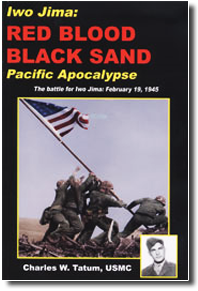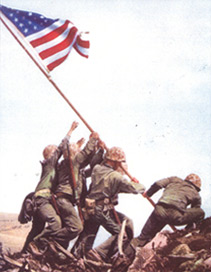Books - Iwo Jima

Red Blood Black Sand - Book
328 pages, 330 photos, maps and illustrations. Order Now!
The capture of Iwo Jima was supposed to have taken three days with relatively minor casualties. More than a month later, 6,821 Americans were dead. The story of Iwo has been told many times before, but this latest account is through the eyes of a Marine PFC. whose experiences, thoughts and feelings are now ours to share. The account focuses not only on the author's experiences but upon those of the men he served with.
An unusual aspect is the inclusion of memoirs of several Japanese officers, offering a different, yet very relevant perspective. This is a contribution to the greater historical account. It is a personalized view of a cataclysmic event, but most of all, it is a tribute to the men who served and who sacrificed under the most arduous of circumstances.
Review From: January/1996 U.S. Naval Proceedings
- Forward by Colonel Justin Gates Duryea
- Has the Japanese battle plans
- Quotes Japanese generals and officers
- Contains the personal recollections of generals, colonels, majors, sergeants, corporals and Pfc.
- Has accurate, and rare historical facts and never before published photographs.
"For someone like myself, an Iwo Jima survivor, it (Iwo Jima: RED BLOOD, BLACK SAND, Pacific Apocalypse) brought back all the bitter memories of our descent through the gates of hell that was Iwo Jima. One word describes the book. TERRIFIC!"
Stan Dobowski, Secretary, Iwo Jima Survivor's Association
Excerpt from the book "Red Blood Black Sand"
What I thought was another mortar shell fell in the same spot as before exploding 75 feet in front of Steve and me. The blast's shock wave whipped up black dirt which pushed its way into my eyes and forced sand into my mouth-gagging me. It was uncomfortable and nasty but my worry wasn't for myself. I hoped it wouldn't foul our weapons.
Basilone ran up, whacked me on the helmet and pointed to the area "mortar" shells had been regularly hitting. Only when sand and dust cleared, could I see Basilone was pointing to the aperture of a reinforced concrete bunker or blockhouse.
The structure probably housed a 75mm or larger cannon whose field of fire was directed down the beach to our right. It was a big ... with incredible killing power. Its shells were stalling the advance by killing men in the Fourth Division. It may have been firing "tree bursts," (Marine-speak for explosions at tree level for anti-personnel destruction.)
Basilone immediately directed Steve and me into action against the hardened concrete emplacement whose walls and roof had withstood our bombardment by 14 and 16 inch shells.
I slapped my machine gun tripod on the deck and Steve snapped our weapon into place. Throwing open the breach, Steve handed me the ammo belt. I slammed the breach over the belt and pulled the bolt back chambering the first round with an authoritative click. I tried to fire the first burst. Nothing happened!
The ... gun wouldn't fire because the breach was full of sand and grit. We had carefully wrapped our weapon in a protective green Marine bath towel intended to prevent crap from jamming the bolt.
It hadn't worked.
"Why in the ... did this have to happen now?"
I threw the breach open again and rolled over on my side while Steve opened my pack and got the cleaning gear out. I used a tooth brush to carefully clear away the sand fouling the breach. This took less than 30 seconds, but seemed like a lifetime.
Lieutenant John A. Dreger, our platoon leader at Camp Tarawa, Hawaii, had drilled us endlessly on this procedure, forcing us to do it blindfolded. Now his training paid rich dividends for us.
I instinctively reloaded, closed the gun, pulled the bolt, and let it slam forward. I was relived when this time it fired and I saw my tracers bouncing harmlessly off the blockhouse.
We weren't penetrating it. My rounds ricocheted impotently off its steel walls. Basilone knelt beside me, looking like he wanted to be the gunner. He watched me in frustration. When my machine gun was finally firing properly, he poked me as a signal to move to the right.
Running 35 feet to the spot picked by Basilone, our field of fire was now oblique to the aperture of the blockhouse cannon. We opened fire again and the tracer rounds were right on target! Now I was pleased with myself!
My bullets forced the ... gunners to close the gun port. With the armored port closed the front of the blockhouse was blind. Even though it was temporarily out of commission, I still wanted to fire at it.




